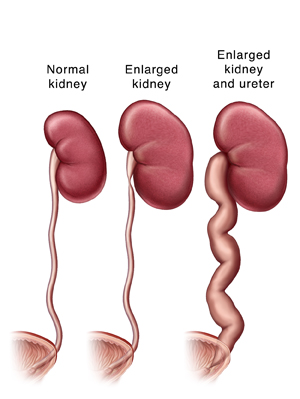When Your Child Has Hydronephrosis
 |
| With hydronephrosis, a problem in the urinary tract keeps urine from draining properly, causing the kidneys to fill with urine. |
One or both of your child’s kidneys is enlarged because of a backup of urine. This is called hydronephrosis. The problem may have been diagnosed before your child was even born. In some children, the problem goes away with time on its own. Other children will need treatment. Your child’s healthcare provider can tell you about treatments. Your child may see a pediatric urologist or nephrologist. These are specialists who manage problems of the urinary tract in children.
What is hydronephrosis?
Hydronephrosis is swelling of a kidney. It's caused by a backup of urine. It may be mild, moderate, or severe.
What causes hydronephrosis?
There can be several causes of urine backup. There may be a blockage in the urinary tract that does not let urine flow normally. Urine may also flow the wrong way (reflux) back up to the kidneys. Or urine may drain too slowly down from the kidneys. These problems can lead to a swollen kidney if they aren't treated. They may also cause lifelong (permanent) damage to the kidney. Tests will be done to find the cause of your child's condition. The healthcare provider will discuss all the treatment choices with you. In rare cases, the blockage may be in the kidney itself.
How is hydronephrosis diagnosed?
A swollen kidney may be seen on ultrasounds done during pregnancy. Once the baby is born, tests may be done to see if it is hydronephrosis. This test is called a kidney (renal) ultrasound. Urine that does not flow normally can lead to a urinary tract infection (UTI). A kidney ultrasound test may be done if a baby or child has a UTI.
How is hydronephrosis treated?
Treatment depends on the cause of the urine backup. It also depends on how severe it is. A mild problem may go away on its own without treatment. If the problem was found with prenatal ultrasound, treatment may wait until the baby is born. The goal of treatment is to protect the child’s kidneys as they grow. Your child’s healthcare provider can talk with you about how best to treat your child. Your child may need:
What are the long-term concerns?
A mild case of hydronephrosis may cause no problems. But a severe case or one that gets worse can lead to kidney damage. Your child’s condition will be watched closely. If needed, treatment can be done to prevent long-term problems.